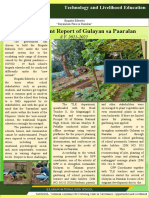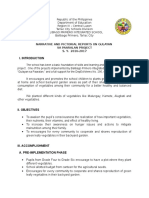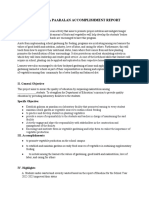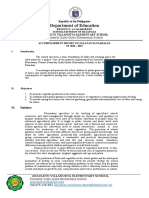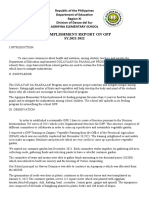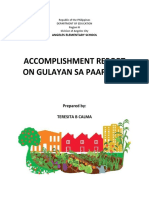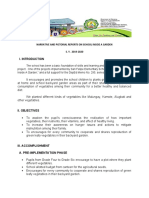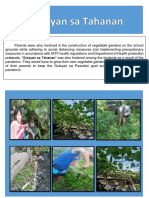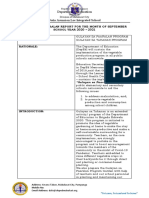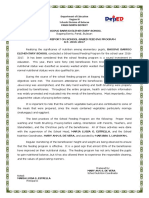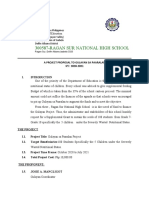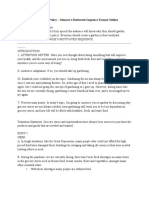Gulayan Sa Paaralan 2023
Gulayan Sa Paaralan 2023
Uploaded by
Alter Juliane SevillaCopyright:
Available Formats
Gulayan Sa Paaralan 2023
Gulayan Sa Paaralan 2023
Uploaded by
Alter Juliane SevillaOriginal Description:
Original Title
Copyright
Available Formats
Share this document
Did you find this document useful?
Is this content inappropriate?
Copyright:
Available Formats
Gulayan Sa Paaralan 2023
Gulayan Sa Paaralan 2023
Uploaded by
Alter Juliane SevillaCopyright:
Available Formats
REPUBLIC OF THE PHILIPPINES
DEPARTMENT OF EDUCATION
REGION XII
DIVISION OF SARANGANI
Alabel 1 District
KIBAC INTEGRATED SCHOOL
Sitio Kibac, Brgy. Pag-Asa, Alabel Sarangani Province
GULAYAN SA PAARAN
School Year 2022-2023
ACCOMPLISHMENT REPORT
I. INTRODUCTION
The Kibac Integrated School, is an institution that responded to the call of the
Department of Education in addressing the malnutrition among school children
through the implementation of the Deped Memorandum No. 295, s. 2007 “Gulayan
sa Paaralan Program”.
The school established and maintained the school garden through
partnership with the stakeholders and the community to ensure its sustainability in
the production of seeds and seedlings for the next cropping. In fact, the school
extended its Program from Gulayan sa Paraalan to Gulayan sa Sitio by providing
seedlings to some of the parents who are 4Ps and IPs recipients through self-help
food production activities as it strengthened the implementation of the program.
Working cooperatively with partners has greater impact in the reformation and
sustainability of the program.
II. OBJECTIVES
To promote sustainable and healthy living by planting vegetables;
To have a vegetable garden in the school vacant lot and near school buildings;
To include among students, teachers and parents the value of gardening,
malnutrition, love of labor and producing their own fresh and healthy food.
III. HIGHLIGHTS
The Grade 7 – 12 students participated in Gulayan sa Paaralan in their TVL
and Organic Agriculture Production subject. After the installation of garden plots,
the cleaned and prepared the soil by plowing and mixing it with garden soil and
organic fertilizer such as vermi cast, and animal manure. They also prepared seeds
like mustasa, petsay, labanos, letsugas and sili in the seedling box. After a few
weeks, they grew and were ready for planted. Then the students started planting
vegetables in their assigned garden plots. Some of the seeds like patola, mais, okra,
kangkong, and sitaw were planted by direct planting. Now we are waiting for the
harvest of those vegetables so that some of them can be used for supplementary
feeding but malunggay were the ones that were used to supplement the daily
feeding of our pupils and students because of its abundant supply in our school.
Some pechay, mustasa, talbos ng sili, and kangkong harvests from our garden plots
were also used for our supplementary feeding.
IV. ISSUES AND CONCERNS
To support the School-based Feeding Program for one hundred twenty (120)
days.
To enhance the skills of each students to learn how to cultivate the soil for
school gardening.
To give importance that vegetables are good for our body.
V. COMMENTS AND SUGGESTIONS
Sustain the use of organic fertilizers in raising vegetables
Continues support from the national budget
Parents involvement in vegetables gardening
VI. CONCLUSION
Gulayan sa Paraalan have numerous benefits and can be a valuable educational
experience for students.
The following conclusion can be drawn after considering various aspects, like;
Educational Value: Gardening and planting vegetables in school provide hands-on
learning opportunities for students; Health and Nutrition: Growing vegetables at school
encourages healthy eating habits among students. It allows them to connect with nature,
understand the importance of fresh and nutritious food, and make healthier choices;
Environmental Awareness: By engaging in gardening activities, students develop a sense
of environmental responsibility. They learn about the importance of conservation,
sustainability, and the impact of their actions on the planet; Social Skills and Teamwork:
Gardening projects promote teamwork and collaboration among students. They learn to
communicate, cooperate, and work together towards a common goal. Gardening also
offers opportunities for interaction with teachers, parents, and the local community,
fostering social connections; Emotional Well-being: Gardening can have a positive impact
on students' mental health and well-being. It provides a calming and therapeutic
experience, allowing students to connect with nature and reduce stress; Sustainability
and Self-Sufficiency: Planting vegetables at school promotes self-sufficiency and
sustainability. It teaches students about food production, reducing reliance on external
sources, and understanding the importance of local and organic agriculture; Community
Engagement: School gardens can serve as a platform for community engagement.
Students can share their harvest with the local community, donate excess produce to food
banks, or organize farmers' markets. This involvement strengthens community ties and
fosters a sense of social responsibility.
In conclusion, planting vegetables in school offers numerous benefits, including
educational value, health promotion, environmental awareness, social skills development,
emotional well-being, sustainability, and community engagement. It provides students
with practical knowledge and skills that extend beyond the classroom, equipping them to
become environmentally conscious and socially responsible individuals.
VII. MODE OF VERIFICATION
[See attachment file]
Prepared by:
DHARELL JAY J. SEVIILA, TII
Gulayan sa Paaralan Coordinator
Noted by:
ARBERT B. LANCHITA
School Head
You might also like
- A Project Proposal To A Gulayan Sa PaaralanDocument3 pagesA Project Proposal To A Gulayan Sa PaaralanKenneth Dumdum Hermanoche100% (6)
- Gulayan Sa Paaralan Accomplishment ReportDocument3 pagesGulayan Sa Paaralan Accomplishment ReportAnthonette Calimpong Bermoy-Burgos90% (10)
- GPP Accomplishment ReportDocument3 pagesGPP Accomplishment ReportMa'am Rakii100% (4)
- Gulayan Sa Paaralan Accomplishment ReportDocument3 pagesGulayan Sa Paaralan Accomplishment ReportGiancarlo Barandino100% (4)
- Gulayan Sa Paaralan Program Accomplishment Report MESDocument7 pagesGulayan Sa Paaralan Program Accomplishment Report MESprincess nicole lugtuNo ratings yet
- Accomplishment Report in CanteenDocument11 pagesAccomplishment Report in CanteenLevz Franco AdunaNo ratings yet
- Gulayan Sa Paaralan CaduldulaoanDocument6 pagesGulayan Sa Paaralan CaduldulaoanRonan Sibbaluca100% (6)
- Narrative Report GulayanDocument4 pagesNarrative Report GulayanAdor Isip91% (103)
- 2009, Procesing Seeds PDFDocument220 pages2009, Procesing Seeds PDFinacho2009No ratings yet
- Accomplishment Report Gulayan Sa PaaralanDocument5 pagesAccomplishment Report Gulayan Sa PaaralanMelody Cabilin100% (1)
- Department of Education: Republic of The PhilippinesDocument2 pagesDepartment of Education: Republic of The PhilippinesARLENE MARASIGANNo ratings yet
- Accomplishment Report On Gulayan Sa Paaralan1Document9 pagesAccomplishment Report On Gulayan Sa Paaralan1joraldNo ratings yet
- Accomplishment Report GulayanDocument12 pagesAccomplishment Report GulayanBianca nicole empeno100% (1)
- Gulayan Sa Paaralan AccomplishmentDocument28 pagesGulayan Sa Paaralan AccomplishmentMARICAR PALMONES100% (1)
- Gulayan Sa Paaralan: Program (GPP)Document12 pagesGulayan Sa Paaralan: Program (GPP)Cecille del RosarioNo ratings yet
- Narrative Report GulayanDocument4 pagesNarrative Report GulayanMylene Solis Dela Pena50% (2)
- Gulayan Accomplishment For Annual ReportDocument11 pagesGulayan Accomplishment For Annual ReportLinrose Go Reyna100% (1)
- Gulayan Sa PaaralanDocument2 pagesGulayan Sa PaaralanMa Teresa Ilarde Magdasoc94% (18)
- ACR Gulayan Sa Paaralan PostDocument4 pagesACR Gulayan Sa Paaralan PostRonaCruzCastro100% (1)
- Gulayan Sa Paaralan Accomplishment ReportDocument5 pagesGulayan Sa Paaralan Accomplishment Reportadad100% (1)
- Gulayan Sa PaaralanDocument6 pagesGulayan Sa PaaralanMark Jessie Panopio Magsaysay100% (5)
- Gulayan Sa Paaralan 2022-2023 - 040129Document5 pagesGulayan Sa Paaralan 2022-2023 - 040129Angela Fernandez AntineroNo ratings yet
- A Narrative Report On Feeding Program 2017Document2 pagesA Narrative Report On Feeding Program 2017RALPH PADDAYUMAN0% (1)
- Gulayan Sa Paaralan Accomplishment Report PERSONASDocument9 pagesGulayan Sa Paaralan Accomplishment Report PERSONASDivine Mercy Manalo MarasiganNo ratings yet
- Gulayan Sa PaaralanDocument2 pagesGulayan Sa PaaralanRomfel Jay Lucas Marquez100% (1)
- Gulayan Sa Paaralan Narrative Report 2021-2022Document3 pagesGulayan Sa Paaralan Narrative Report 2021-2022Mark Gil Jalbuena Alteza100% (1)
- BE Gulayan Sa Paaralan, BE Gulayan Sa TahananDocument3 pagesBE Gulayan Sa Paaralan, BE Gulayan Sa TahananMamaanun PS100% (1)
- A Gulayan Sa Paaralan Project ProposalDocument5 pagesA Gulayan Sa Paaralan Project ProposalGiancarlo Barandino100% (3)
- Department of Education Doña Asuncion Lee Integrated SchoolDocument9 pagesDepartment of Education Doña Asuncion Lee Integrated SchoolJohn EviotaNo ratings yet
- A Gulayan Sa Paaralan Project Proposal For Feeding ProgramDocument5 pagesA Gulayan Sa Paaralan Project Proposal For Feeding ProgramRosalyn Llaguno100% (1)
- Narrative and Pictorial Report On Gulayan Sa PaaralanDocument2 pagesNarrative and Pictorial Report On Gulayan Sa Paaralansheynie100% (2)
- Annual-Accomplishment-Report Feeding 2023Document5 pagesAnnual-Accomplishment-Report Feeding 2023MARITA GONZALES100% (3)
- Gulayan Sa Paaralan ProgramDocument2 pagesGulayan Sa Paaralan ProgramVon Lloyd Ledesma Loren100% (2)
- Gulayan Sa Paaralan ProgramDocument7 pagesGulayan Sa Paaralan ProgramDivine Grace Samortin75% (4)
- Action Plan TleDocument7 pagesAction Plan TleAilyn EstolasNo ratings yet
- Gulayan Sa PaaralanDocument3 pagesGulayan Sa PaaralanJaneDandanNo ratings yet
- Gulayan Sa Paaralan and TahananDocument1 pageGulayan Sa Paaralan and TahananDon Angelo De GuzmanNo ratings yet
- Narrative Report GPPDocument2 pagesNarrative Report GPPMaricar Briones Palmones80% (5)
- ACR in Gulayan Sa PaaralanDocument22 pagesACR in Gulayan Sa PaaralanWILLBERT BALANGAT50% (2)
- Action Plan EPP and Gulayan Sa PaaralanDocument2 pagesAction Plan EPP and Gulayan Sa PaaralanMarilyn Bido100% (2)
- GPP - (S.Y. 2021-2022) ACR and Action PlanDocument2 pagesGPP - (S.Y. 2021-2022) ACR and Action Plangomer baniaga100% (3)
- Project Proposal To A Gulayan Sa Paaralan 2023-2024Document4 pagesProject Proposal To A Gulayan Sa Paaralan 2023-2024Jonathan BernardoNo ratings yet
- GPP Narrative ReportDocument1 pageGPP Narrative ReportJohn Dale Evangelio100% (1)
- ACCOMPLISHMENT REPORT Nutrition 2018-19Document7 pagesACCOMPLISHMENT REPORT Nutrition 2018-19Princess May Olea ItaliaNo ratings yet
- Harvested Vegetables - For FeedingDocument4 pagesHarvested Vegetables - For FeedingGladys QuiloNo ratings yet
- Nutrition Month ReportDocument4 pagesNutrition Month ReportFelipe DionisioNo ratings yet
- Narrative Report of Gulayan Sa PaaralanDocument1 pageNarrative Report of Gulayan Sa PaaralanUniss100% (9)
- Accomplishment Report - Gulayan Sa Paaralan 2022-2023Document6 pagesAccomplishment Report - Gulayan Sa Paaralan 2022-2023LizBay100% (1)
- Republic of The Philippines Department of Education Region X - Northern Mindanao Iligan City Division Suarez National High SchoolDocument9 pagesRepublic of The Philippines Department of Education Region X - Northern Mindanao Iligan City Division Suarez National High SchoolDesay Ace BurlNo ratings yet
- Nutrition Action Plan: Department of Education Schools Division OfficeDocument5 pagesNutrition Action Plan: Department of Education Schools Division OfficeJas MinNo ratings yet
- Brigada Narrative Report 2021Document2 pagesBrigada Narrative Report 2021KIARA CAMILLE RIBANO100% (1)
- Action Plan - AgriDocument3 pagesAction Plan - AgriMark Jayson Galvadores63% (8)
- ACR CanteenDocument2 pagesACR CanteenSusie Cruz100% (5)
- SBM Accomplishment Report: I. Title of Activity II. Inclusive Date/Time: Iii. Venue: IV. ParticipantsDocument3 pagesSBM Accomplishment Report: I. Title of Activity II. Inclusive Date/Time: Iii. Venue: IV. ParticipantsLileth Delos Reyes Bernardino100% (1)
- Gulayan Sa Paaralan Action PlanDocument2 pagesGulayan Sa Paaralan Action PlanDerick Maceda90% (10)
- Gulayan Sa Paaralan Best PracticesDocument1 pageGulayan Sa Paaralan Best Practicesjulie joy75% (4)
- Narrative Report On SBFP 2022Document4 pagesNarrative Report On SBFP 2022Marjun BartoloNo ratings yet
- Feeding Narrative Bagong Barrio EsDocument9 pagesFeeding Narrative Bagong Barrio EsDivina S. ArenaNo ratings yet
- Narrative Report GulayandocxDocument8 pagesNarrative Report GulayandocxAlle LunagNo ratings yet
- Nutritional Status and School Participation of School Feeding ProgramDocument3 pagesNutritional Status and School Participation of School Feeding Programangel lopezNo ratings yet
- Gulayan-sa-Paaralan (1) Project ProposalDocument15 pagesGulayan-sa-Paaralan (1) Project ProposalLuisa Francisco Garcillan83% (6)
- A Philippine Exhibition PavilionDocument3 pagesA Philippine Exhibition PavilioncainnhmmmNo ratings yet
- 2nd PT HELE 6Document3 pages2nd PT HELE 6astiachieversschooloftabacoincNo ratings yet
- Hydroponics Innovative Farming Without SoilDocument4 pagesHydroponics Innovative Farming Without Soilmegalanrajendiran18No ratings yet
- Case Study Residential Gardening Online Case StudyDocument9 pagesCase Study Residential Gardening Online Case Studypratik patilNo ratings yet
- Soal Pat BHS Ing Google FormDocument16 pagesSoal Pat BHS Ing Google FormFEBRIAN BAYU PRADANANo ratings yet
- HerbicideclassificationDocument1 pageHerbicideclassificationlf8116435No ratings yet
- Tomato Production ManualDocument86 pagesTomato Production ManualAbubakar Jamil100% (2)
- About MicrogreensDocument27 pagesAbout MicrogreensJohan SukweenadhiNo ratings yet
- Canada Thistle: Cirsium Arvense (L.) ScopDocument3 pagesCanada Thistle: Cirsium Arvense (L.) ScopGregory BakasNo ratings yet
- Vegetation Analysis and Weed ManagementDocument12 pagesVegetation Analysis and Weed ManagementElprida PurbaNo ratings yet
- VSC 301 - Breeding Bitter Gourd - PPT 1 - Agri JunctionDocument32 pagesVSC 301 - Breeding Bitter Gourd - PPT 1 - Agri Junctionsivakarthikkeyen321No ratings yet
- Persuasive Speech Outline Draft 4Document4 pagesPersuasive Speech Outline Draft 4AlexisNo ratings yet
- Grafting WatermelonsDocument5 pagesGrafting WatermelonsFelicity1No ratings yet
- Maac Workshop January 11, 2014Document30 pagesMaac Workshop January 11, 2014Denisa HysaNo ratings yet
- Chat WordsDocument12 pagesChat Wordsconvictex12No ratings yet
- Urban GardeningDocument28 pagesUrban GardeningENANO Jayryl D.No ratings yet
- Farm Worker: Mr. Azedine DjelouliDocument2 pagesFarm Worker: Mr. Azedine DjelouliAyat MedjahedNo ratings yet
- Trimmer PartsDocument29 pagesTrimmer PartsHAVENSALNo ratings yet
- Intercropping of Some Brassica Crops Wit PDFDocument10 pagesIntercropping of Some Brassica Crops Wit PDFBhushan GosaviNo ratings yet
- Prallel Practice Task ACP 9 Q4 WK 1 3Document3 pagesPrallel Practice Task ACP 9 Q4 WK 1 3Mela ChuNo ratings yet
- Akarkara EnglishDocument7 pagesAkarkara EnglishClick-N-Grow Agroventures Pvt LtdNo ratings yet
- Bentham and Hooker Classification System - OecDocument22 pagesBentham and Hooker Classification System - OecDAVALDARIYA WALIKARNo ratings yet
- Lecture 4 Current StatusDocument14 pagesLecture 4 Current StatusRonin MeshuggaNo ratings yet
- Conservation of Plant DiversityDocument134 pagesConservation of Plant DiversityAna CalmîșNo ratings yet
- WalkDocument4 pagesWalkJamal NasirNo ratings yet
- Reproduction in Lower and Higher PlantsDocument89 pagesReproduction in Lower and Higher Plantsmohdyasir6643100% (1)
- Acer Saccharum Sugar Maple, Florida Maple, Hard Maple, Rock Maple PFAF Plant DatabaseMED 2Document2 pagesAcer Saccharum Sugar Maple, Florida Maple, Hard Maple, Rock Maple PFAF Plant DatabaseMED 2João RodriguesNo ratings yet
- Effects of Pre-Sowing Treatments On Seed Germination Of: Melia AzedarachDocument4 pagesEffects of Pre-Sowing Treatments On Seed Germination Of: Melia AzedarachjoanalucasNo ratings yet
- Plant Organs System: Roots & Stem Leaf Flower & FruitsDocument38 pagesPlant Organs System: Roots & Stem Leaf Flower & FruitsSweet EmmeNo ratings yet


